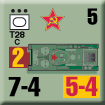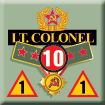| Panzer Grenadier: Workers & Peasants
Developer’s Preview, Part Three
February 2014
Here's the final installment of our scenario preview of Panzer Grenadier: Workers and Peasants. It covers the last scenario section in the book, which chronicles the battles fought around the Russian town of Borodino in 1941.
BORODINO 1941
Scenario One
Stopped Cold
10 October 1941
 While advancing along the Minsk highway, SS Reich Division encountered heavy resistance just outside of Budayevo on October 9th. With darkness fast approaching the SS men pulled back for the evening, but early the next morning they set out to overcome the opposition. While advancing along the Minsk highway, SS Reich Division encountered heavy resistance just outside of Budayevo on October 9th. With darkness fast approaching the SS men pulled back for the evening, but early the next morning they set out to overcome the opposition.
Note: This scenario uses a board from Road to Berlin, a board and pieces from Eastern Front and pieces from Sinister Forces.
Conclusion
The newly raised 18th Tank Brigade was engaging in its first combat, but it was well led. Concealing themselves in the woods, they easily stopped Der Führer Regiment (which as usual suffered massive causalities). After the battle, an urgent request went out to XL Panzer Corps for armor support. A battalion from 10th Panzer Division was soon on its way to help.
Commentary
An interesting study of battle between unbalanced forces: A large force of SS infantry with little tank or AT support attacking a smaller force of superior Red Army tanks whose only infantry support is an even smaller number of SMG units. It being early in the war, the SS troops are poorly trained and inexperienced so they don’t have higher morale than the equally inexperienced Soviets. So while the Germans outnumber the Soviets 2 to 1, their morale will start breaking as soon as they get within the Soviet tanks’ direct fire range. And unless their meager tank support can inflict disproportionate losses on the Soviet tanks, the SS infantry will have little choice but to endure massive opportunity fire at point-blank range in order to set up assaults on Soviet positions. As for the Soviets, they win the scenario by holding roads and town hexes and by inflicting losses on the Germans. So they must attempt to stand their ground, which becomes problematic if the Germans are able to close the distance on them without becoming demoralized. This is because any Soviet tanks that are not stacked with any of the relatively scarce SMG units will wither fast in assault combat against the far more numerous German infantry.
Scenario Two
Crossing the Kolothcy
13 October 1941
With their new reinforcements from 10th Panzer Division, SS Reich Division now planned to cross the Kolothcy River to put pressure on the Soviets blocking the Minsk Highway.
Note: This scenario uses a board from Road to Berlin, a board and pieces from Eastern Front and pieces from Sinister Forces and this supplement.
Conclusion
The bridge over the river had been destroyed, which seemed to surprise the German tankers. While milling around in confusion they quickly saw six of their number destroyed, and the infantry that soon arrived and tried to force its way across the river was also unsuccessful. Additional infantry was able to cross the river and reach the enemy entrenchments on the other side, but a Soviet counterattack soon drove the Germans back.
Commentary
Here the inexperienced SS men get substantial tank support from the professionals, but the outnumbered Red Army force holding the river line gets reinforcements from an elite NKVD infantry battalion during play. This means that the Germans need to attack very aggressively if they want to have a chance of taking VP-producing town hexes and holding them against NKVD counterattacks.
Scenario Three
Turning the Tables
14 October 1941
 After mixed successes farther south, at midmorning XL Panzer Corps struck hard out of Rogachevo. The strength added by the just-arrived 11th SS Regiment allowed the Germans to secure Utitzy and Artemki. This threatened to unhinge the entire Soviet position at Borodino. After mixed successes farther south, at midmorning XL Panzer Corps struck hard out of Rogachevo. The strength added by the just-arrived 11th SS Regiment allowed the Germans to secure Utitzy and Artemki. This threatened to unhinge the entire Soviet position at Borodino.
Note: This scenario uses boards from Battle of the Bulge and Elsenborn Ridge, and pieces from Eastern Front, Sinister Forces and this supplement.
Conclusion
Like the cavalry in an old Western movie, the missing elements of the 32nd Rifle Division arrived in the nick of time. Wasting no time, the Recon Battalion headed straight for Artemki while gathering what infantry forces they found along the way to help. Soon Artemki was back in Soviet hands. At about the same time, the 322nd Rifle Regiment arrived and launched an attack that drove the Germans back to where they had started.
Commentary
Here a high-morale Soviet infantry force attacks the SS infantry holding a two-board front. The best division in the Red Army - which probably should have higher morale - faces the overrated criminals in black. Reinforcements may arrive in time to save the Soviets; or maybe not.
Scenario Four
Yelnia Falls
14 October 1941
Tenth Panzer Division's Brigade von Hauenschild had finally arrived and was ordered to advance up the Minsk highway. Their first serious obstacle was thought to be Yelnia. Gathering the panzers that had been attached to SS Reich, they sallied forth in an attack straight off the march.
Note: This scenario uses boards from 1940: The Fall of France, Battle of the Bulge and Road to Berlin, and pieces from Eastern Front and Red Warriors. Only use leaders from Eastern Front and this supplement.
Conclusion
Yelnia soon fell to Hauenschild's hardened warriors, but they were unable to drive the Soviets from the high ground east of the village. A new, more carefully prepared attack would be needed on the following morning.
Commentary
 Here the high-morale Soviet troops of 32nd Rifle Division are counterattacked by a real German Army formation from 10th Panzer Division. The well-balanced German force has plenty of armor support while the Soviets have none, but the terrain is highly defensible with lots of town and woods terrain plus a river running through the towns. This will be a tough fight since both sides have the same morale, but the Soviets have far more town hexes to cover than they can defend and the Germans have air support too. Here the high-morale Soviet troops of 32nd Rifle Division are counterattacked by a real German Army formation from 10th Panzer Division. The well-balanced German force has plenty of armor support while the Soviets have none, but the terrain is highly defensible with lots of town and woods terrain plus a river running through the towns. This will be a tough fight since both sides have the same morale, but the Soviets have far more town hexes to cover than they can defend and the Germans have air support too.
Scenario Five
A Stronger Effort
15 October 1941
With SS Reich Division having taken and then lost both Artemki and Utitzy all on the same day, LX Panzer Corps ordered Brigade von Hauenschild to swing part of their force south to retake Utitzy. Both sides had been bloodied on the previous day but the stakes were too high to allow time for regrouping.
Note: This scenario uses boards from Battle of the Bulge and Elsenborn Ridge, and pieces from Eastern Front, Sinister Forces and this supplement.
Conclusion
Early in the battle, the commander of SS Reich Division was seriously wounded when his halftrack was hit by a Katyusha rocket. Nevertheless, the SS men rallied to take Artemki in heavy fighting, only to be thrown out again by a counterattack. On the other hand, Utizy fell to Brigade von Hauenschild and remained in German hands. Farther north the Soviet 5th Army’s commander would be seriously wounded organizing a defensive line against Brigade von Hauenschild.
Commentary
Here two separate forces from 2nd SS Division and 10th Panzer Division (Wehrmacht) counterattack the Red Army’s 32nd Rifle Division on the same map where Scenario Three (“Turning the Tables”) was fought.
Scenario Six
Strength Renewed
16 October 1941
 Two days of hard fighting had bled the under-strength Brigade von Hauenschild nearly white, so the belated arrival of its second infantry regiment was greeted with joy and relief. With its strength renewed, the brigade now hoped to advance up Moscow Highway while also breaking 32nd Rifle Division's ability to resist. Two days of hard fighting had bled the under-strength Brigade von Hauenschild nearly white, so the belated arrival of its second infantry regiment was greeted with joy and relief. With its strength renewed, the brigade now hoped to advance up Moscow Highway while also breaking 32nd Rifle Division's ability to resist.
Note: This scenario uses boards from 1940: The Fall of France, Battle of the Bulge and Elsenborn Ridge, and pieces from Eastern Front and Red Warriors. Only use leaders from Eastern Front and this supplement.
Conclusion
The newly arriving infantry turned the tide of battle in the Germans’ favor. The initial fury of the German drive pushed the 322nd Rifle Regiment out of Semenovskaya and Borodino Station, but spirited Soviet counterattacks retook Borodino Station and stopped the Germans cold in the hills beyond Semenovskaya.
Commentary
This large scenario is the final showdown between 10th Panzer and 32nd Rifle Division, with the by-now-useless SS men having been withdrawn from action. This is a very large scenario, and again, the 32nd Rifle is probably under-rated in terms of morale.
Scenario Seven
Deja Vu
16 October 1941
For the third day in a row SS Reich Division took possession of Artemki, and for the third day in a row the Soviets launched a counterattack to liberate the town. Twentieth Tank Brigade had just been formed in Vladimir near Moscow a couple of weeks before and now rushed to the front to join 5th Army's desperate struggle for Borodino.
Note: This scenario uses a board from Battle of the Bulge and pieces from Eastern Front and Sinister Forces.
Conclusion
When the fresh 20th Tank Brigade hit the worn-down Deutschland Regiment, the SS men were unable to effectively reply. That night Artemki was once again in Soviet hands. The SS would try again the following day, when the Soviets had finally run out of fresh troops to fling into the battle.
Commentary
 This is a simple town-taking scenario on a small board. The SS men might actually have a chance to hold the town since 20th Tank Brigade does not have the higher morale of 32nd Rifle Division and since the tank brigade’s only infantry support comes from SMG units. This is a simple town-taking scenario on a small board. The SS men might actually have a chance to hold the town since 20th Tank Brigade does not have the higher morale of 32nd Rifle Division and since the tank brigade’s only infantry support comes from SMG units.
That covers it for Workers and Peasants.
Click here to order Workers and Peasants TODAY! |
